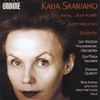Saariaho Orchestral Works
Piece-meal programming but some first-rate performances
View record and artist detailsRecord and Artist Details
Composer or Director: Kaija Saariaho
Genre:
Orchestral
Label: Ondine
Magazine Review Date: 13/2004
Media Format: CD or Download
Media Runtime: 69
Mastering:
Stereo
DDD
Catalogue Number: ODE1047-2

Tracks:
| Composition | Artist Credit |
|---|---|
| Du cristal |
Kaija Saariaho, Composer
Esa-Pekka Salonen, Conductor Kaija Saariaho, Composer Los Angeles Philharmonic Orchestra |
| ... à la fumée |
Kaija Saariaho, Composer
Anssi Karttunen, Cello Esa-Pekka Salonen, Conductor Kaija Saariaho, Composer Los Angeles Philharmonic Orchestra Petri Alanko, Alto flute |
| Nymphea, 'Jardin secret III' |
Kaija Saariaho, Composer
Kaija Saariaho, Composer Kronos Qt |
| (7) Papillons |
Kaija Saariaho, Composer
Anssi Karttunen, Cello Kaija Saariaho, Composer |
Author: Fabrice Fitch
If there is a link between the pieces on this cobbled-together CD, I’d tent- atively suggest the cello, which features in all three. Saariaho views Du crystal and …à la fumée as a single work, but they appear equally capable of standing individually, since they are as contrasted as their models suggest (fossilized stone on the one hand, and smoke on the other). Du crystal is the more approachable of the two, its form more immediately legible, and many of its gestures reminiscent of Ligeti in the ’60s, particularly Lontano. The twist is that in Du crystal, the orchestra is much less ‘distant’; the use of percussion, and the more prominent brass (far closer to Sibelius than Ligeti ever allowed), see to that.
In …à la fumée, the orchestra is joined by two soloists, alto flute and cello, both modified electroacoustically. This is a tougher nut to crack; although it is only five minutes longer than Du crystal, the scale is considerably broader, the gestures more drawn out and the form distended by the largely isolated interventions of the concertante duo in a work that fully demonstrates the richness of Saariaho’s aural imagination.
A more immediately arresting work, perhaps, is the string quartet Nymphéa, in which again the instruments are treated with live electronics. The appearance of melodic elements is held in constant tension by the proximity of what is called ‘noise’; in this sense, the distortions/transformations only accentuate the natural capabilities of the instruments, and Saariaho is particularly adept at playing with this duality. The Kronos Quartet turn in a typically gutsy performance (one that makes me wish that they’d harness themselves to this aesthetic territory a bit more often).
The final work, the much more recent Sept papillons, was written for one of the soloists of …à la fumée, Anssi Karttunen. Karttunen’s booklet-note points out that these miniatures were written in the immediate aftermath of the opera L’Amour de loin, and one does get a sense of relaxation, of doodles that draw you deep into the acoustics of the ‘cello. It’s a fitting postlude to a very enjoyable recital. My opening quibble is in no way intended to dampen a positive response to first-rate performances, let alone to music that has this much to offer.
In …à la fumée, the orchestra is joined by two soloists, alto flute and cello, both modified electroacoustically. This is a tougher nut to crack; although it is only five minutes longer than Du crystal, the scale is considerably broader, the gestures more drawn out and the form distended by the largely isolated interventions of the concertante duo in a work that fully demonstrates the richness of Saariaho’s aural imagination.
A more immediately arresting work, perhaps, is the string quartet Nymphéa, in which again the instruments are treated with live electronics. The appearance of melodic elements is held in constant tension by the proximity of what is called ‘noise’; in this sense, the distortions/transformations only accentuate the natural capabilities of the instruments, and Saariaho is particularly adept at playing with this duality. The Kronos Quartet turn in a typically gutsy performance (one that makes me wish that they’d harness themselves to this aesthetic territory a bit more often).
The final work, the much more recent Sept papillons, was written for one of the soloists of …à la fumée, Anssi Karttunen. Karttunen’s booklet-note points out that these miniatures were written in the immediate aftermath of the opera L’Amour de loin, and one does get a sense of relaxation, of doodles that draw you deep into the acoustics of the ‘cello. It’s a fitting postlude to a very enjoyable recital. My opening quibble is in no way intended to dampen a positive response to first-rate performances, let alone to music that has this much to offer.
Discover the world's largest classical music catalogue with Presto Music.

Gramophone Digital Club
- Digital Edition
- Digital Archive
- Reviews Database
- Full website access
From £8.75 / month
Subscribe
Gramophone Full Club
- Print Edition
- Digital Edition
- Digital Archive
- Reviews Database
- Full website access
From £11.00 / month
Subscribe
If you are a library, university or other organisation that would be interested in an institutional subscription to Gramophone please click here for further information.




